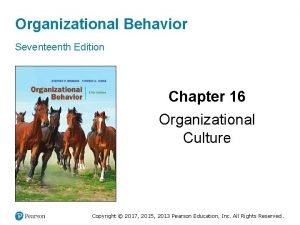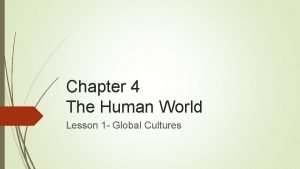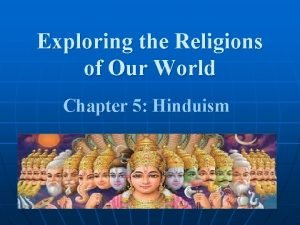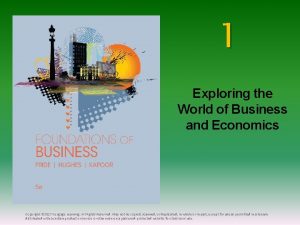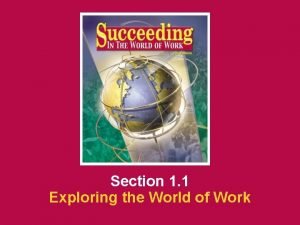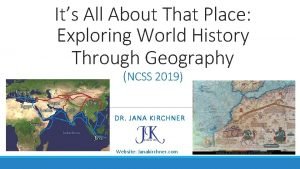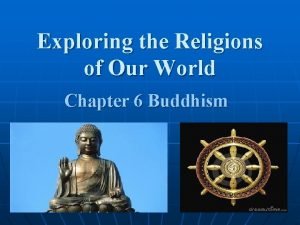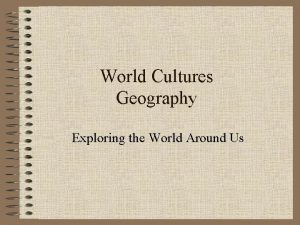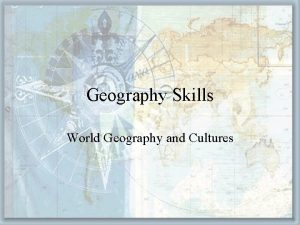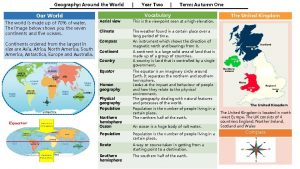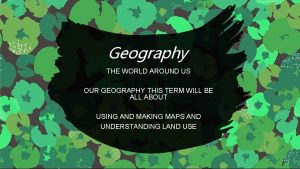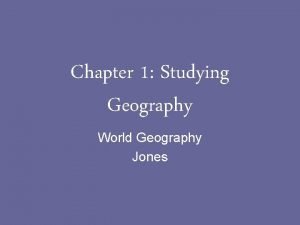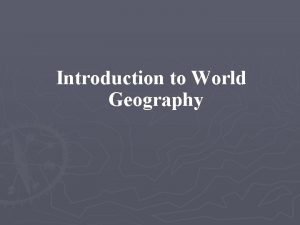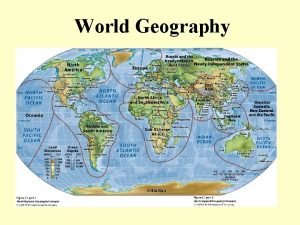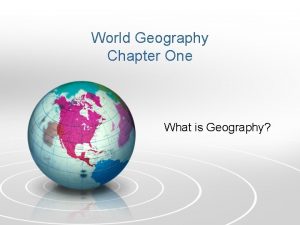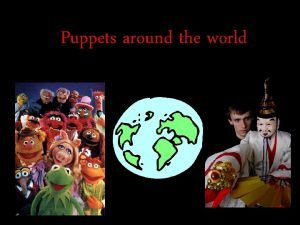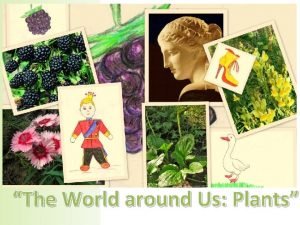World Cultures Geography Exploring the World Around Us














- Slides: 14

World Cultures & Geography Exploring the World Around Us

Geography: the study of the Earth • Geography comes from the Greek word geo meaning “earth” and graphy meaning “science of”. • Study of people, environment, and resources. • Maps, globes, charts, and graphs.

5 Themes of Geography Location Place Interaction between people and Environment Movement Region

Location: Position on the Earth’s surface. Two ways to determine location: 1) Absolute - 2) Relative –

Location (continued) Absolute Location: A place’s exact location on the Earth. Example: 37. 9319˚ N (Latitude), 121. 6958˚ W (longitude). Latitude/Parallels: Are imaginary lines that run horizontally around the globe: East & West. Longitude/Meridians: Are imaginary lines that circle the globe vertically: North to South.

Location (continued) • Relative location: This term explains where a place is by describing places near it. – Oakley/Brentwood area is about 60 miles southeast of San Francisco Turn to a partner & give them a relative location of a store of your choice.

Place: Physical and human characteristics or features of a location. 1) Physical features • Water • Climate (hot or cold) • Land (hilly, flat, etc. ) 2) Human characteristics • Reasons why people live in a certain area • How many people live in a certain place • What kind of work people do

Place Turn to a partner & give them the physical features and human characteristics of a place of your choice. BE PREPARED TO SHARE OUT.

Human-Environment Interaction • HEI: The theme of how people affect their environment, the physical characteristics of their natural surroundings, and how their environment affects them. • People change their environment – Examples: Clearing forests, damming rivers, and digging tunnels. • Consequences of people’s actions: – Environmental impact such as erosion, pollution, and fertile land.

Human-Environment Interaction (continued) • People adapt – People change to suit environment • Eskimo’s • Chinese stir fry – People change environment • deserts to fertile land • valleys flooded for lakes, dams, etc.

Human-Environmental Interaction Turn to a partner & brainstorm different HEI’s Brentwood/Oakley has had in the last 10 years. BE PREPARED TO SHARE OUT.

Movement: helps explain how people, goods, and ideas get from one place to another • Migration: the movement of people from one country or region to another in order to make a home – Why migrate? • food, work, trade (imports and exports) – Ideas spread – Cultural changes and Mix of cultures – Interdependence • globalization and trade

Regions: Areas with their own unique characteristics which unify their locations. – – Geographical or land Culture or history Political or economic Religion or beliefs • Geographers use theme of regions to make comparisons. – On maps, geographers use color and shape or special symbols to show regions – A place can be part of several regions at the same time • Houston, Texas is both a plains region and an oil producing region

Remembering the 5 Themes • If you can’t remember what they are, just ask MR. HELP M – Movement R – Regions He – Human Environment interaction L – Location P - Place
 Organizational cultures often reflect national cultures.
Organizational cultures often reflect national cultures. Guided reading activity the human world
Guided reading activity the human world What goes around comes around example
What goes around comes around example Goes around comes around meaning
Goes around comes around meaning Exploring religions chapter 5 large
Exploring religions chapter 5 large Exploring the world of business and economics
Exploring the world of business and economics Exploring the religions of our world chapter 2 pdf
Exploring the religions of our world chapter 2 pdf Exploring the religions of our world chapter 1 pdf
Exploring the religions of our world chapter 1 pdf Exploring the world of work
Exploring the world of work Exploring world history
Exploring world history Exploring the religions of our world
Exploring the religions of our world Religion
Religion Exploring the religions of our world
Exploring the religions of our world Ap human geography frqs
Ap human geography frqs 5 themes of geography ap human geography
5 themes of geography ap human geography
